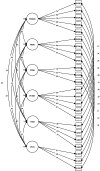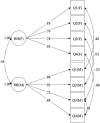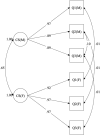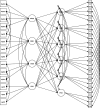The Dyadic Influence of Relationship Hope on Family Functioning
- PMID: 40243005
- PMCID: PMC12004348
- DOI: 10.1111/famp.70036
The Dyadic Influence of Relationship Hope on Family Functioning
Abstract
There is a continued need to understand family factors that can promote child well-being and reduce their risks for mental health problems. Drawing from research on family dynamics and using a cross-sectional design, this study examined the association between relationship hope, couple satisfaction, and family functioning using the actor-partner interdependence model (APIM) on dyadic data collected from 537 opposi-gender, ethnically diverse, low-income couples. Results indicated that, while accounting for couple satisfaction as a covariate, women's relationship hope was positively associated with their own perceptions of parental teamwork and family relationship. Men's relationship hope was positively linked with their own perceptions of parental teamwork and parent-child relationships. Additionally, men's level of relationship hope positively influenced women's perceptions of family relationships. Findings highlight the systemic nature of relationship hope and its relationship to enhanced family functioning. Implications for clinical practice focus on the importance of fostering relationship hope within couples to promote positive parenting practices and family stability.
Keywords: family functioning; parenting; relationship hope.
© 2025 The Author(s). Family Process published by Wiley Periodicals LLC on behalf of Family Process Institute.
Conflict of interest statement
The authors declare no conflicts of interest.
Figures




Similar articles
-
The Relationship Between Social Support and Family Relationships Among Low-Income Couples Attending Relationship Education.Fam Process. 2020 Dec;59(4):1498-1516. doi: 10.1111/famp.12499. Epub 2019 Oct 18. Fam Process. 2020. PMID: 31625604
-
Is it harmful to me or to us? A dyadic analysis of Chinese young adults' dysfunctional individuation and romantic relationship satisfaction.Int J Psychol. 2024 Apr;59(2):279-287. doi: 10.1002/ijop.13092. Epub 2023 Nov 28. Int J Psychol. 2024. PMID: 38013615
-
Application of the dyadic data analysis in behavioral medicine research: marital satisfaction and anxiety in infertile couples.BMC Med Res Methodol. 2018 Oct 26;18(1):117. doi: 10.1186/s12874-018-0582-y. BMC Med Res Methodol. 2018. PMID: 30367603 Free PMC article.
-
Actor-Partner Interdependence Model Analysis of Sexual Communication and Relationship/Family Planning Factors Among Immigrant Latino Couples in the United States.Health Commun. 2017 May;32(5):612-620. doi: 10.1080/10410236.2016.1160317. Epub 2016 Jul 1. Health Commun. 2017. PMID: 27367797 Free PMC article.
-
Coercive control during the transition to parenthood: An overlooked factor in intimate partner violence and family wellbeing?Aggress Behav. 2019 Mar;45(2):139-150. doi: 10.1002/ab.21803. Epub 2018 Dec 5. Aggress Behav. 2019. PMID: 30516286
References
-
- Adler‐Baeder, F. , McGill J., Frosch C. A., Wei M., and Coskun M.. 2025. “The Impact of Couple Relationship Education (CRE) on Parents of Young Children's Couple Functioning, Family Harmony, Parenting and Their Children's Aggressive Behaviour.” Early Child Development and Care 195, no. 1‐2: 1–16. 10.1080/03004430.2025.2452578. - DOI
-
- Alarcon, G. M. , Bowling N. A., and Khazon S.. 2013. “Great Expectations: A Meta‐Analytic Examination of Optimism and Hope.” Personality and Individual Differences 54, no. 7: 821–827. 10.1016/j.paid.2012.12.004. - DOI
-
- Allan, R. , Klarenbeek‐McKenna M., and Day D.. 2019. “‘Somebody Watching You’: Impact of Reflecting Teams on Hope in Couple Relationships.” Australian and New Zealand Journal of Family Therapy 40, no. 4: 383–399. 10.1002/anzf.1388. - DOI
-
- Asay, T. P. , and Lambert M. J.. 1999. “The Empirical Case for the Common Factors in Therapy: Quantitative Findings.” In The Heart and Soul of Change: What Works in Therapy, edited by Hubble M. A., Duncan B. L., and Miller S. D., 33–56. American Psychological Association.
-
- Azam, A. , and Hanif R.. 2011. “Impact of Parents' Marital Conflicts on Parental Attachment and Social Competence of Adolescents.” European Journal of Developmental Psychology 8, no. 2: 157–170. 10.1080/17405620903332039. - DOI
MeSH terms
Grants and funding
LinkOut - more resources
Full Text Sources
Medical

